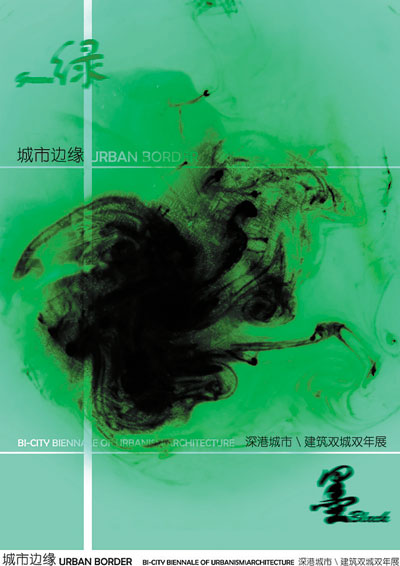
Anna Zhao
anna.whizh@yahoo.com
FIVE posters and five videos stood out from more than 100 entries to be the winner of an international student poster and video competition of the 2013 Bi-city Biennale of Urbanism/Architecture (UABB) for their creative exploration of urban culture, space, lives and other related issues.
As an important event of the UABB, the competition invited interpretations of “Urban Boundaries” from students by casting artistic insight on the diverse characteristics of urban cities. It also promoted cultural exchange between young, international, talented people while excavating their sense of creativity and innovation through design and photography.
The first-prize winner for poster design was “Black vs. Green,” created by Chen Lijing from South China Agricultural University. Chen displayed the impact of urban expansion through tainted ink in green and black. The green color with an increasingly stronger black tint symbolized the fate of nature in the process of urban expansion, a problem that is growing extraordinarily prominent in Chinese cities. The process of urbanization is redefining the original color of our earth in a destructive way, like the encroaching black ink with green.
The second-prize poster winner, Zhang Xiaoyuan from Hubei Institute of Fine Arts, told the story of a wounds-laden leaf that fell victim to the worsening environment. In this poster, the natural environment is marginalized by the rapid development of cities with towering buildings and magnificent construction. In other words, urban cities develop at the price of exploiting natural environment. As an indicator of the urban environment, the leaf reminds humankind that a good environment is indispensible for human’s survival and a lack of environmental protection will lead to the collapse of cities.
Another second-prize winner, “Memories of Derelict City” by Han Yujia and Bu Nan’s team from Tongji University, showed that the boundary of a city has an emotional connection between people and the city where they live, rather than an estrangement between cities or between cities and rural areas. When the emotional bond breaks, the “boundary” will appear. A city is constituted of the people who share its streets and memories. Using a montage of different pictures, the poster showed a combination of two groups of buildings that crossed time, in which the upper old buildings are mirrored in water with modern high-rises. An aged man sitting with an uneasy posture between the pictures seemed to be pondering with anxiety the impact of urban sprawl.
The poster attempted to promote people’s thinking on the changes brought about by urban expansion on people’s lives, social relations and conflicts, and raise awareness for humanity and history.
Sarah Stasiuk from University of Manitoba in Canada won third prize for the exploration of boundary conditions within a slice of the city of Winnipeg, Canada.
The poster mapped the natural environment of different places surrounding the city’s border by using materials of various textures to represent different districts. The textural mapping of border conditions depicted not only the material qualities and conditions within each district, but also some personal interpretations or emotions experienced in certain areas. The map also served as a reminder of the pervasive influence of nature on urban development.
Cao Mengying from Hubei Institute of Fine Arts also placed third for a depiction of a city built in the shape of a tree trunk. The poster directed social concerns on natural ecology and environment by displaying the fact that in the process of urban expansion, the ecological balance is destroyed while more farmland is turned into urban areas.
The first place winner of the video category was “Garden on Ruins” by Ye Qiming’s team from Tongji University. Their piece demonstrated how people could regenerate a garden on derelict ground.
One of the second-prize winners, “Nightmare Shanghai” by Bei Yingjie’s team from Tongji University, used black and white color and a heavy tone to capture another illusive face of the city in decay. Another second-prize winner, “Heart of the Continent” by Liane Lanzar from University of Manitoba, was a group of comic-style drawings illustrating the formation of a city and the interaction of the elements inside or related to the city.
The third-prize winners were Hong Kong artist Wang Zhenquan and Dazhong Yi from University of Manitoba, Canada. All the prize-winning videos are available on Youkou.com.
|

